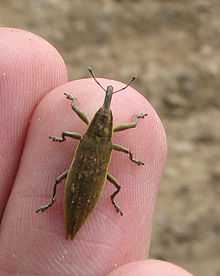Lixinae
From Wikipedia, the free encyclopedia
| Lixinae | |
|---|---|
 | |
| Lixus iridis | |
| Scientific classification | |
| Kingdom: | Animalia |
| Phylum: | Arthropoda |
| Class: | Insecta |
| Order: | Coleoptera |
| Suborder: | Polyphaga |
| Infraorder: | Cucujiformia |
| Superfamily: | Curculionoidea |
| Family: | Curculionidae |
| Subfamily: | Lixinae |
| Tribes | |
|
Cleonini | |
Lixinae is a subfamily of true weevils, included in the Molytinae in many older treatments. They are mainly root feeders, although some develop in flower buds or stems. Several species are used in biological control of invasive weeds, namely knapweeds (Centaurea).
Characteristics include tarsal claws that are fused at the base, and labial palps are short and telescoping. The body is elongate shape, as for some other weevils. Each tibia bears an uncus (small hook) on its distal end. The rostrum is forwardly directed.
There are three tribes. The largest of these by far are the Cleonini, sometimes ranked as an independent subfamily in the past:
Cleonini
|
|
|
|
|
|
Lixini
|
|
Rhinocyllini
- Bangasternus
- Rhinocyllus
External links
| Wikimedia Commons has media related to Lixinae. |
| Wikispecies has information related to: Lixinae |
This article is issued from Wikipedia. The text is available under the Creative Commons Attribution/Share Alike; additional terms may apply for the media files.